|
|
|
Sort Order |
|
|
|
Items / Page
|
|
|
|
|
|
|
| Srl | Item |
| 1 |
ID:
152866
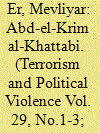

|
|
|
|
|
| Summary/Abstract |
Abd-el-Krim al-Khattabi's guerilla tactics are said to have influenced several renowned revolutionaries, such as Ho Chi Minh and Mao Zedong. There is evidence that Che Guevara equally employed at least some of the tactics and methods, which were devised by the Rifis. After all, Alberto Bayo, the much respected guerilla trainer of Che, had fought during his military career for a relatively long period of time against the Rifis. Castro, yet another role model for Che, mentions in his biography that he read about the battle of Annual, one of the most successful attacks against the Spanish initiated by Abd-el-Krim in 1921. There are also claims that Che had met Abd-el-Krim in 1959 in Cairo. Castro does not mention that he had discussed with Che anything about his readings on the Rif War, but he clearly states that Bayo used to teach in his camp guerilla methods that he had encountered during his assignments in Morocco. However, neither Bayo nor Che (or their biographers) mention that any of the tactics imparted during the training were from the time of Abd-el-Krim's struggle. The only person praised by both men is the Nicaraguan rebel leader Augusto César Sandino. This article compares the tactical teachings of Bayo as well as the operational methods used by Che during his battles in Cuba with the methods applied by the Rifis under Abd-el-Krim's leadership, and highlights a number of tactical similarities. It also finds that the guerilla tactics applied by Sandino have little in common with the methods described by Bayo.
|
|
|
|
|
|
|
|
|
|
|
|
|
|
|
|
| 2 |
ID:
152884
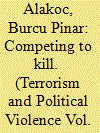

|
|
|
|
|
| Summary/Abstract |
Are organizationally linked suicide attacks deadlier than those launched by lone wolf terrorists? This article elaborates a perpetrator-based distinction among suicide terrorist attacks between organizations and lone wolf terrorists, who operate in the absence of a financially or physically supportive terrorist organization. The expectation is that terrorist organizations would serve as commitment tools that increase the loyalty of suicide bombers to their missions through material and non-material incentives. Findings demonstrate that when terrorist organizations are involved in the planning and execution of suicide terrorist attacks, not only do they increase the lethality of these attacks but they also accentuate the tactical advantages of suicide terrorism. These findings suggest that despite the recent upsurge and concern about lone wolf terrorism, the lethality and security impacts of suicide terrorism continue to be driven by terrorist organizations.
|
|
|
|
|
|
|
|
|
|
|
|
|
|
|
|
| 3 |
ID:
152870


|
|
|
|
|
| Summary/Abstract |
The issue of terrorism has been a significant source of influence on the relationship between Iran and the U.S. since the Islamic Revolution. Iran's friendship with extremist groups that are designated as terrorist groups by the U.S. State Department is seriously challenging America's foreign policy. This article attempts to explore the prospect of confrontations on the issue of terrorism between Iran and the U.S. through a detailed analysis of their different interpretations and mutual recognitions of terrorism and through an in-depth analysis of the measures each party has taken regarding this confrontation. This article argues that the confrontation between Iran and the U.S. regarding the issue of terrorism is not strictly about terrorism. Rather, it is also about the conflicts of policies that result from different security interests and political values. Resolving the issue of terrorism depends on the reconciliation of the relationship between Iran and the U.S. Without mutual trust between the two nations, Iran will continue to support extremist groups in order to increase its influence against the external and internal pressures it is currently under, and the U.S. will continue to contain Iran's regional ambitions and seek changes in its behavior.
|
|
|
|
|
|
|
|
|
|
|
|
|
|
|
|
| 4 |
ID:
152871
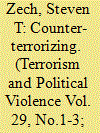

|
|
|
|
|
| Summary/Abstract |
In this article I identify and evaluate numerous reasons why torture became common practice during the state counterterrorism campaign in Peru between 1980 and 2000, despite international and domestic legal obligations to protect human rights. I describe common structural conditions, organizational factors, and individual-level explanations often associated with torture practices. I then identify seven logics and motivations behind torture use in counterterrorism campaigns. I describe and analyze actual torture use in Peru using quantitative incident-level data, and I provide descriptive statistics concerning variation in the frequency and methods of torture. Finally, I examine specific incidents of torture to illustrate and assess the different logics and motivations for torture. I draw heavily from testimonies collected by Peru's Truth and Reconciliation Commission. I also rely on personal interviews carried out during fieldwork in the Junín and Ayacucho regions of Peru. I find that aggregate torture incidents generally coincide with political developments and shifts in violence levels and that the various state security forces used torture differently. A review of testimonies regarding specific incidents of torture suggests that multiple logics motivate state security forces, even for a single incident of torture, complicating academic efforts to formulate a parsimonious causal explanation.
|
|
|
|
|
|
|
|
|
|
|
|
|
|
|
|
| 5 |
ID:
152874
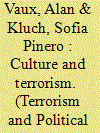

|
|
|
|
|
| Summary/Abstract |
The relationship between terrorism and culture was systematically examined using three high-quality global databases. Contrary to prior research, terrorism—collapsed across form and era—was not related to any of Hofstede's cultural dimensions. Yet, particular forms of terrorism—incidents involving substantial casualties and damage, suicide bombings, and the proportion of incidents involving fatalities—all showed relationships with cultural dimensions. Tolerance of terrorism and relative tolerance of the 9/11 attack were related to cultural dimensions and terrorist events. Finally, populations that were relatively voiceless, disengaged from their communities, suffering, angry, and hopeless showed more tolerance of terrorism and incidents of terrorism.
|
|
|
|
|
|
|
|
|
|
|
|
|
|
|
|
| 6 |
ID:
152885
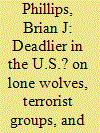

|
|
|
|
|
| Summary/Abstract |
Scholars, politicians, and pundits increasingly suggest lone wolf terrorists are substantial threats, but we know little about how dangerous these actors are—especially relative to other terrorist actors. How deadly are lone actor terrorists? A growing body of empirical research focuses on terrorist organizations, but similar work on lone actors is sparse. Furthermore, attempts to explicitly compare these or other types of terrorist actors are almost non-existent. This article considers theoretical arguments for why lone wolves ought to be especially lethal. However, it presents an argument for why terrorist groups should generally be more lethal. This argument is conditional upon the environment in which actors operate. Lone wolves should only be more deadly in states with especially strong counterterrorism capacity. The article uses data on terrorist attacks in fifteen developed countries, 1970–2010, to compare the lethality of terrorist acts. Around the world, attacks by organizations tend to be far more lethal than attacks by other actors. In the United States, however, lone wolves are generally the more lethal terrorist actors. This is argued to be because the robust counterterrorism capacity makes organized terrorism more difficult to accomplish.
|
|
|
|
|
|
|
|
|
|
|
|
|
|
|
|
| 7 |
ID:
152872
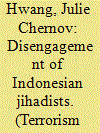

|
|
|
|
|
| Summary/Abstract |
While much research has been conducted on the radicalization of Muslim militants from Jemaah Islamiyah, its spinoffs, and splinter factions; the historical roots of Indonesian radical movements; and their ideological underpinnings, far less analysis has centered on how and why individual militants may come to disengage from violence. Disengagement is defined as a gradual process through which a member of a terror group, radical movement, gang, or cult comes to reject the use of terror methods in pursuit of their goals. Utilizing original fieldwork conducted between 2010 and 2014, with fifty current and former members of Islamist extremist groups in Indonesia, this article will unpack the patterns, pathways, religious considerations, and psychological processes that propel individual militants to turn away from violence.
|
|
|
|
|
|
|
|
|
|
|
|
|
|
|
|
| 8 |
ID:
152877
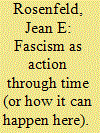

|
|
|
|
|
| Summary/Abstract |
The purpose of this paper is to discuss how fascism may be identified by its actions, the stages through which a fascist rule takes power, and how to recognize it before it does so. The thesis is that a fascist takeover of a democratic government is rapid and unexpected. Its goal is a revolutionary reversal of representative government in the name of the people, while it accomplishes the opposite: a single-party corporate regime that replaces individual liberty with subtle, bureaucratic, and overt types of coercion. Rather than generate a generic definition of the many types of fascism, it is more useful to study how it affects the lives of ordinary people, the milieu out of which it develops, and what its precursors look like. Understanding fascism entails studying it from the point of view of those who lived under it and recorded their experiences, as well as from the analytic perspectives of social scientists. As Robert O. Paxton observes: “The fascist phenomenon was poorly understood at the beginning in part because it was unexpected.”1Robert O. Paxton, “The Five Stages of Fascism,” in Fascism: Critical Concepts in Political Science, edited by Roger Griffin, vol. I (2004), Chapter 14, 305–26.
View all notes
We are facing the question again in 2017 with the surprise election of Donald Trump as the forty-fifth president of the United States by a minority of the popular vote and the evident support of the white nationalist milieu. Paxton proposes a five-stage theory for understanding fascism in its many varieties. A developmental sequence is proposed against which current events in the United States may be assessed.
|
|
|
|
|
|
|
|
|
|
|
|
|
|
|
|
| 9 |
ID:
152886
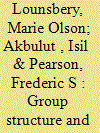

|
|
|
|
|
| Summary/Abstract |
Studies have begun to look at the potentially crucial impacts of group decentralization and inter-group global networking in accounting for the extent and severity of violence in insurgencies and terrorism. Groups may be able to survive more effectively, evade anti-terror or counter-insurgency strategies, and inflict greater damage or more civilian attacks by operating under more or less centralized leadership, or by making use of the resources of other like-minded groups scattered across borders. While some analysts have examined each of these possibilities, few if any have done so simultaneously with both structural and networking indicators or examined the joint effects of these indicators. We propose to do so in this study by combining existing datasets on terrorist structure and networks. Hypotheses and findings in prior studies have indicated that structural decentralization may lead to more civilian attacks if not more destruction since local cells are freer to act on their own, and that group size and centrality in the global terror networks lead to greater lethality and group survival rates. We re-examine such assumptions here with OLS and logit models combining these effects, and find that in addition to group size, network reach (eigenvalue centrality) rather than group interconnections per se (number of allies) appears to have primary impacts on group lethality, targeting, and survival, sometimes in conjunction with decentralized organizational structure.
|
|
|
|
|
|
|
|
|
|
|
|
|
|
|
|
| 10 |
ID:
152881
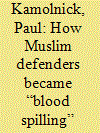

|
|
|
|
|
| Summary/Abstract |
Adam Gadahn's Abbottabad letter offers a rare opportunity to examine how this Al Qaeda Senior Leadership (AQSL) media operative and spokesman conceptualizes and executes media warfare. In this article, I first introduce, depict, and employ the author's Terrorist Quadrangle Analysis (TQA) as a useful heuristic for conceptualizing and representing the four interrelated components of the AQSL terrorist enterprise: political objectives, media warfare, terrorist attacks, and strategic objectives. This TQA construct is then employed to conceptualize Gadahn's media warfare acumen. Gadahn is shown to be an adept communications warfare operative who conscientiously disaggregates and evaluates key target audiences, messengers, messaging, and media. Gadahn's vehement critique of select “jihadi” groups, in particular Tehrik-i-Taliban (TTP), al-Shabaab, and the Islamic State of Iraq (ISI), is then described. Key here is how and why Gadahn denounces their indiscriminate, murderous terrorist attacks on Muslim non-combatant civilians and other protected persons as effectively subverting his intended AQSL media warfare strategy and undermining AQSL strategic and religio-political objectives. A concluding section briefly summarizes these chief findings, offers select implications for scholarship and counter-AQSL messaging strategy, and identifies study limitations.
|
|
|
|
|
|
|
|
|
|
|
|
|
|
|
|
| 11 |
ID:
152863
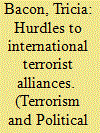

|
|
|
|
|
| Summary/Abstract |
Despite the threat posed by international terrorist alliances, the conditions that foster and inhibit these relationships remain poorly understood. When seeking allies outside of their primary conflict and political market, groups struggle to forge credible commitments, particularly the requisite ‘shadows of the future’ and reputations conducive to cooperation, without third-party enforcers. Given their suspicious nature and strong in-group identities, terrorist groups sometimes balk at relinquishing independence for security. Alliances risk precipitating counterterrorism pressure, alienating constituents, and increasing the risk of betrayal. Even groups that enjoy alliance success, like Al Qaeda, experience these hurdles in their alliance. What helped to set Al Qaeda apart from most groups was its ability to navigate these obstacles, though some bedeviled its alliances efforts. This offers under-utilized opportunities for alliance disruption.
|
|
|
|
|
|
|
|
|
|
|
|
|
|
|
|
| 12 |
ID:
152876


|
|
|
|
|
| Summary/Abstract |
The percentage of Israelis killed by terrorism is higher than in any other democracy. The article analyzes the threats Israel has faced, the impact terrorism has had on Israel, and the counter-terrorism policies Israel has adopted. Terrorism has had a decisive effect on Israeli elections and national security decisions, but not the economy. Israeli counter-terrorism has often been conducted without a coherent overall policy, has failed to reflect and conflicted with broader objectives, and has greatly undermined Israel's international standing. Conversely, it has enabled Israel to live in relative security and thrive, and provided its leaders with the latitude to pursue various policies, including peace, should they wish to do so.
|
|
|
|
|
|
|
|
|
|
|
|
|
|
|
|
| 13 |
ID:
152879


|
|
|
|
|
| Summary/Abstract |
Sinclair Lewis, the first American to win the Nobel Prize in Literature, anticipated many aspects of Donald J. Trump's 2016 campaign and election in his 1935 satirical dystopia, It Can't Happen Here. It was his most popular novel to date and is still satisfying, thought-provoking political theater. Lewis was influenced by growing totalitarianism in Europe, reported on by his second wife, foreign correspondent, Dorothy Thompson. Noting the power of Father Coughlin and Huey Long, among others, to mobilize a public still suffering from the Great Depression, Lewis feared a fascist takeover of the American government by democratic means. Lewis's fictional nightmare features a loutish, ignorant demagogue, who is manipulated by a sinister ghostwriter adviser. With support from a resentful League of Forgotten Men, the demagogue is elected President and quickly establishes a military, racist, and anti-Semitic dictatorship. It Can't Happen Here dramatizes the dire consequences of this takeover, which is not taken seriously at first by Lewis's newspaper editor protagonist, but then is increasingly resisted. Lewis is a social satirist in the Mark Twain tradition, and his novel is worth reading today for its suggestive parallels with current history and its good-hearted humor.
|
|
|
|
|
|
|
|
|
|
|
|
|
|
|
|
| 14 |
ID:
152873
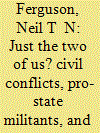

|
|
|
|
|
| Summary/Abstract |
Quantitative literature discussing violence in civil conflicts tends towards a typical model of engagement between governments and revolutionaries. Whilst recent work has shown the significant impact of multiple anti-government groups, a further feature remains understudied—the role of pro-state militants. This article theorizes a “violence premium” when such groups arise, which leads to all connected groups devoting greater energy to conflict than they would in isolation. Employing duration analysis and data from The Troubles in Northern Ireland, where Republicans act as revolutionary insurgents, Loyalists as pro-state militants, and the British Army as government forces, the violence premium is empirically confirmed. Both Loyalists and Republicans deviate from their underlying strategies to attack more frequently when violence by their rivals increases, with Republicans and the British Army engaging in the same way. An extended analysis, accounting for the status of the victim, shows that the violence premium resulting from interaction between Loyalists and Republicans targeted only the civilian population of Northern Ireland, elucidating the sectarian component of The Troubles. These results show that including all conflict parties and considering how they are linked are important features in studies that aim to determine the net level of violence in civil conflicts.
|
|
|
|
|
|
|
|
|
|
|
|
|
|
|
|
| 15 |
ID:
152865
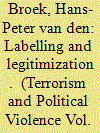

|
|
|
|
|
| Summary/Abstract |
This article focuses on the role of labelling in the discourse employed by the Left-Wing Nationalist movement in the Basque Country to legitimize the use of violence for political ends. The approach in this article goes beyond classic labelling theory. I demonstrate that radical Nationalists do not passively undergo their being labelled as deviants (fanatics, terrorists) by society, but develop counter-labels instead to define their opponents and re-label themselves.
|
|
|
|
|
|
|
|
|
|
|
|
|
|
|
|
| 16 |
ID:
152862
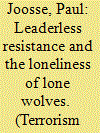

|
|
|
|
|
| Summary/Abstract |
“Leaderless resistance” and “lone wolf terrorism” are concepts that have steadily gained importance in the study of oppositional subcultures and terrorist groups, being used to describe the operational realities of a variety of terrorisms, from groups like Al Qaeda to Anders Breivik. In this article, I seek to describe leaderless resistance as a rhetorical construct, a meaning-conferring “ideology of effervescence” that lifts the spirits of both movement progenitors who advocate the strategy as well as incipient lone wolves who consider responding to their exhortations. Through an examination of the case of Wiebo Ludwig and the EnCana pipeline bombings of 2008–2009, I show how these rhetorics emerge in the interactions between activists and their political enemies. With this conception, we can (a) understand more fully the discursive/rhetorical dynamics involved in asymmetrical struggle, (b) problematize the acceptance of the organizational reality of leaderless resistance in the terrorism literature, and (c) question the assertion of some terrorism scholarship that refers to leaderless resistance and other ideologies of effervescence as hallmarks of the “new terrorism.”
|
|
|
|
|
|
|
|
|
|
|
|
|
|
|
|
| 17 |
ID:
152867
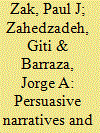

|
|
|
|
|
| Summary/Abstract |
Persuasive narratives can induce some individuals to engage in costly actions. Entrepreneurs of suicide missions frame the necessity of violent behavior within the context of persuasive narratives to attract potential recruits. Herein we report results from an experiment to test factors involved with costly action linked to a persuasive narrative. We recruited 164 participants (M = 21, SD = 5.20) and measured hormones, electrodermal activity, and personality to predict who would be influenced by the narrative's message. We found that the persuasive narrative we tested resulted in costly action by those who are high-perspective takers and are more physiologically aroused by the narrative. The findings fill lacunae in the literature, providing a novel approach to examine costly behavior (like martyrdom missions) in the laboratory.
|
|
|
|
|
|
|
|
|
|
|
|
|
|
|
|
| 18 |
ID:
152883
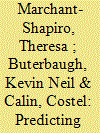

|
|
|
|
|
| Summary/Abstract |
This article is one of the first to systematically assess the ability of state fragility measures to predict violent protests and adverse regime changes in countries. We focus on the Arab Spring as an example of a situation that such measures ought to predict. Through a variety of analyses, we find that none of the measures are predictive. We then create a simple model using the literature of protest and revolts to predict both the level of violence and the extent of regime change in the Arab Spring countries. This simpler model does a better job of predicting the level of involvement in the Arab Spring than any of the complex State Fragility Indexes. Thus, the goal of this article is not to explain the causes of the Arab Spring, but to add to the discussion of the predictive value of measures of instability.
|
|
|
|
|
|
|
|
|
|
|
|
|
|
|
|
| 19 |
ID:
152880


|
|
|
|
|
| Summary/Abstract |
The “fringe”—rejected and marginalized ideas and beliefs—has historically been clearly divided from the cultural and political mainstream. However, recent technological developments have weakened the boundary separating them. The Internet and social media have made it possible for fringe ideas to move much more readily into the mainstream. The Trump campaign was accompanied by the massive infusion of fringe motifs including the denigration of ethnic and religious groups; the support of political extremists; and the acceptance of conspiracy theories. As the fringe becomes legitimated by this mainstreaming, the possibilities for violence increase.
|
|
|
|
|
|
|
|
|
|
|
|
|
|
|
|
| 20 |
ID:
152878
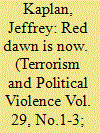

|
|
|
|
|
| Summary/Abstract |
This article details the long-standing struggle within the American far right between those whose mission it is to resist the perceived subversion of international communism and its neo-Soviet successors now in power in the Kremlin and those whose mission is dedicated to preserving the White Race from the twin threats of miscegenation and marginalization from the corridors of power. Using the metaphor of the 1984 low-budget spectacular Red Dawn and noting the current pattern of Russian interference in the election and contacts with the Trump campaign, it traces the struggle from the ascendancy of anti-communism in the 1950s and 1960s to the current triumph of the race warriors and conspiracy theorists who championed the candidacy of Donald Trump. “Red Dawn Is Now” concludes with the observation that, for those who most fear foreign subversion, the revelations about Russian penwetration of the American election process and the Trump presidency represents a 21st-century version of the Soviet occupation that the young patriots of Red Dawn fame successfully repelled. If this is so, it suggests the possibility that Thomas Jefferson's observation that “the tree of liberty must be refreshed from time to time with the blood of patriots & tyrants” may be prophetic and that the fifth wave of terrorism might at long last be at hand.
|
|
|
|
|
|
|
|
|
|
|
|
|
|
|
|
|
|
|
|
|